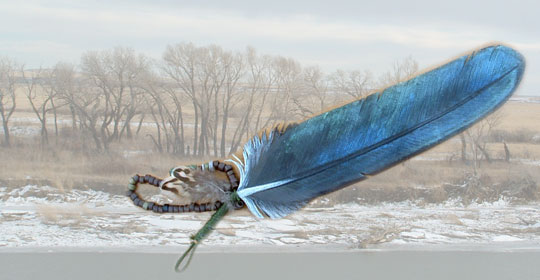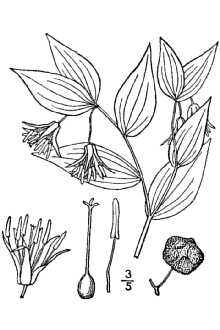Iimitaohkatsi – Prosartes trachycarpa S. Wats. (Fairybells, Dog feet)

This is a raven feather. Ravens like to eat Roughfruit Fairybell.
Roughfruit Fairybells

Prosartes trachycarpa S. Wats.
USDA-NRCS PLANTS Database / Britton, N.L.& Brown,A.
This fragile plant has thin, delicate leaves and creamy flowers that hang from the tips of its ‘branches’. In the summer, the tiny white flowers become a rough and leathery fruit divided into three sections, turning first yellow and then brilliant red; looking much like a small brightly coloured peach.
These berries can be eaten raw. A tea of bark can be used as an eyewash for snowblindness.
Dispore à fruit velu
Cette plante fragile a des feuilles minces et délicates ainsi que des fleurs de couleur crème qui sont suspendues du haut de ses “branches”. L’été, ses petites fleurs se transforment en fruits rugueux et velus composés de trois sections. Au début, ils sont jaunes, puis ils passent au rouge vif. Ces fruits, qui peuvent être mangés crus, ressemblent à de petites pêches à la couleur flamboyante.
Le thé d’écorce de dispore à fruit velu peut aussi aider à combattre la cécité des neiges lorsqu’il est mis dans les yeux sous la forme de gouttes.
- Britton, N.L.& Brown,A. (1913). Illustrated flora of the northern states and Canada. Vol. 2: 156. The PLANTS Database (http://plants.usda.gov). National Plant Data Center, Baton Rouge, LA 70874-4490 USA. Retrieved Feburary 20, 2005 http://plants.usda.gov
- Hellson, John C. (1974). Ethnobotany of the Blackfoot Indians. Ottawa: National Museums of Canada.
- Johnston, Alex. (1987). Plants and the Blackfoot. Lethbridge, Alberta: Lethbridge Historical Society.
- Kerik, Joan. (1979). Living With The Land: Use of Plants by the Native People Of Alberta.Edmonton, Alberta: Provincial Museum of Alberta.
- Moerman, Daniel E. (1998). Native American Ethnobotany. Portland: Timber Press.





